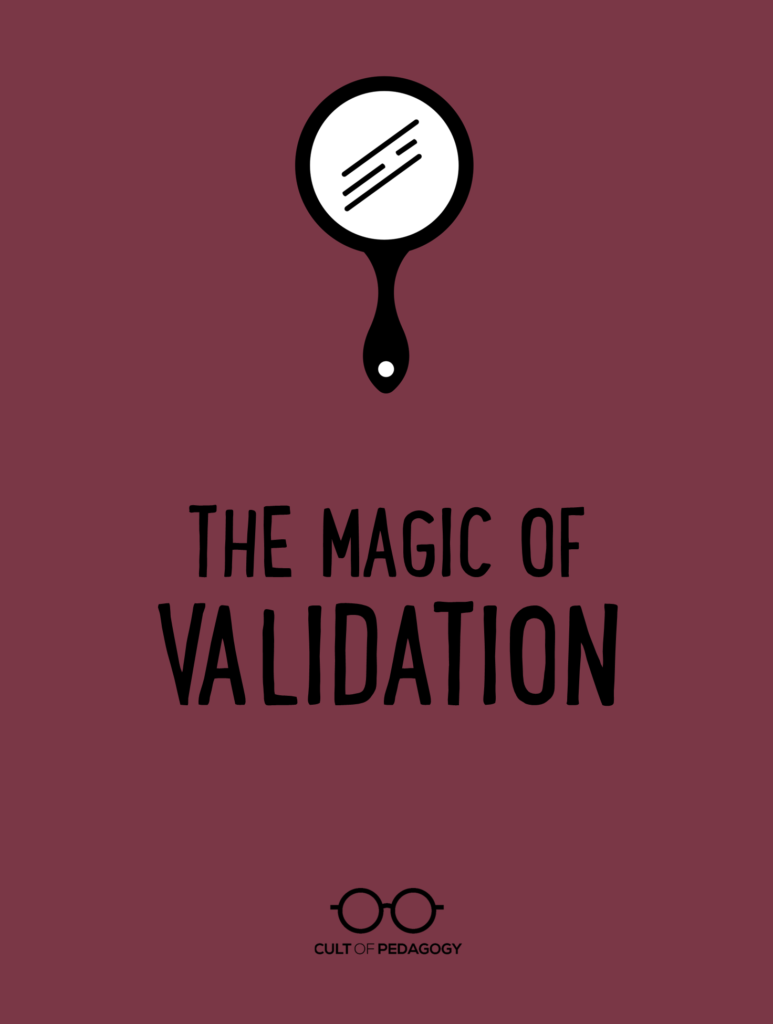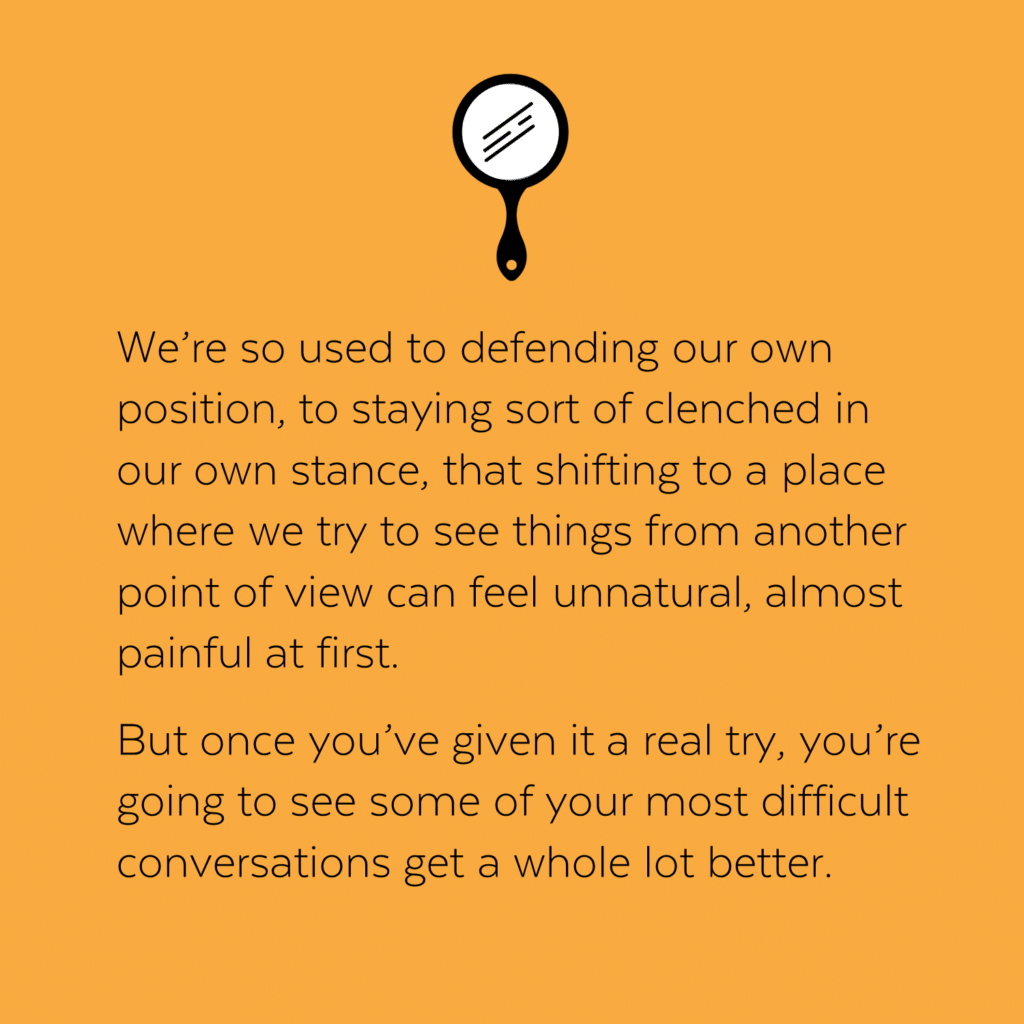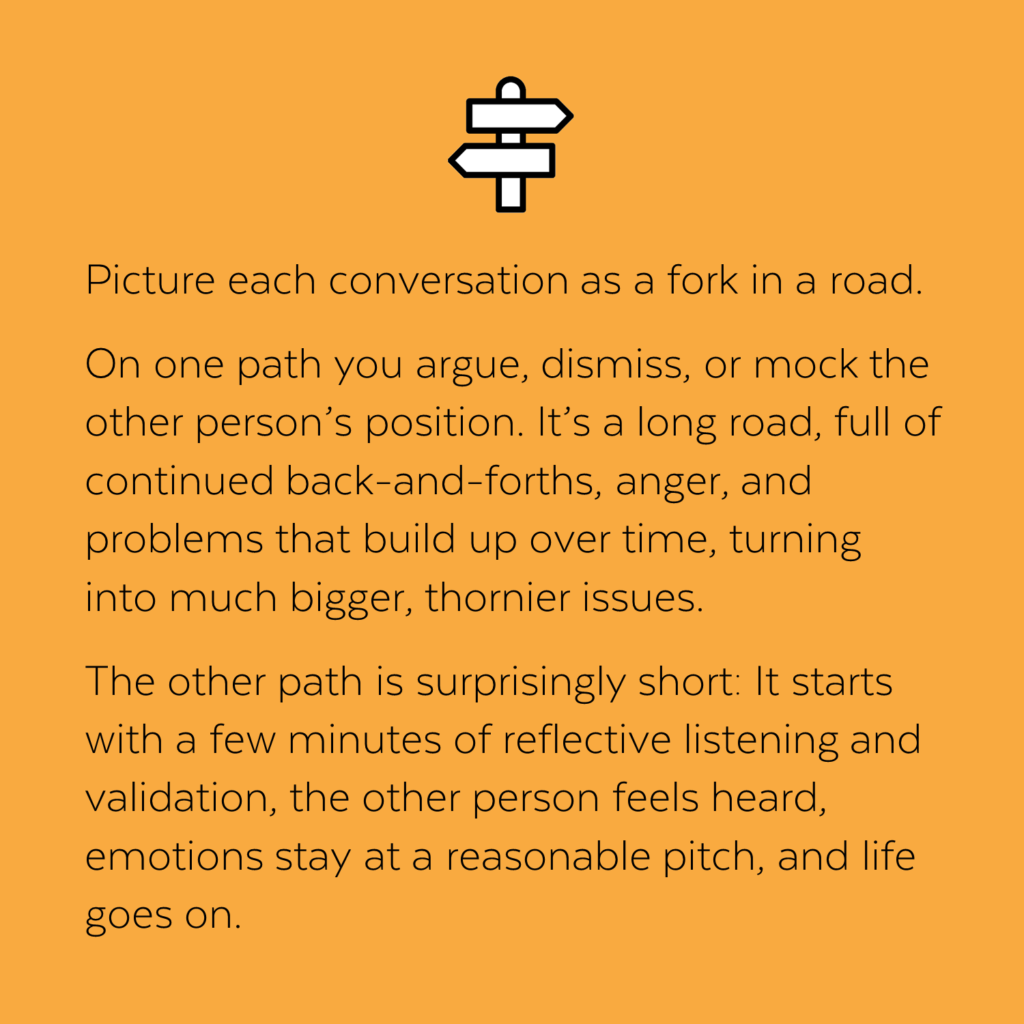
Listen to this post as a podcast:
Sponsored by Kiddom and mysimpleshow
I have a multiple-choice question for you.
Suppose you’re standing at your classroom door, greeting students as they arrive. One of them—let’s call him Gabe—comes through and sees that on the daily agenda, you’ve written “Choose topics for speeches.” Right away, his shoulders slump.
“Oh man,” he says to no one in particular, “I hate speeches!”
What do you say?
A. What? Speeches are awesome.
B. You talk all the time! You’re gonna love it.
C. Shocker! Gabe has another complaint.
D. Gabe, we enter the room silently, please.
E. What do you hate about speeches, Gabe?
With options A through D, you’re arguing with Gabe, dismissing his feelings, attacking him personally, or ignoring what he said altogether.
But with option E, you’re reacting with curiosity. You’re trying to learn more. With option E, you’re already on your way to validating Gabe’s point of view.
Validation is the act of recognizing and affirming the feelings or perspective of another person. It’s acknowledging that these thoughts and feelings are true for that person. It’s a very simple, astoundingly fast way to make progress in a conversation: It eases tension, builds trust, and gets you and the other person to a solution more quickly.
The only problem with validation is that at first, it’s really hard to do. We’re so used to defending our own position, to staying sort of clenched in our own stance, that shifting to a place where we try to see things from another point of view can feel unnatural, almost painful at first. But once you’ve given it a real try, you’re going to see some of your most difficult conversations get a whole lot better.

Why Validation Works
People want to be understood. They want to feel heard.
When a person doesn’t feel heard, she just clings more tightly to her own position. It really is that simple, and it’s one of the reasons so many conflicts last so long and often escalate to ridiculous proportions. People on both sides of any conflict try and try to explain and defend themselves, to make the other person see something the way they see it.
And unfortunately, our typical responses usually make the situation worse:
Arguing with the other person’s viewpoint, like saying that speeches are awesome in response to Gabe’s statement, is a natural reaction, but it probably won’t impact his opinion. He’ll most likely want to come back with an argument about why speeches do suck, and you’ll just go back and forth. Until he feels heard, Gabe will have a hard time considering your point of view.
Dismissing the other person’s feelings, like pointing out to Gabe that he talks all the time and therefore couldn’t possibly dislike speeches, will not only not change his mind, it will also make him feel misunderstood. His original negative emotion tied to speeches has now been joined by a feeling of frustration that you just don’t get him. And depending on how serious the underlying problem is, your flippant dismissal could really hurt.
Ignoring the person’s concern by focusing on something else, like we did when we merely addressed a rule about being quiet, can make a person feel like they just don’t matter. Reminding Gabe to enter the room quietly doesn’t actually change his mind about the speeches. It hasn’t taken any of the negative feelings away. And by completely ignoring his concern, we are telling him that his feelings just aren’t important.
Ad hominem attacks, like the snide comment about Gabe complaining all the time, are another way of dismissing and delegitimizing the other person’s viewpoint. When our students voice a concern and we accuse them of being insubordinate, asking “silly questions,” or trying to stall or waste time, we are attacking them personally while avoiding the content of what they’re saying. This response can be the most destructive: Not only does the person still feel the way they felt before, but now they have added a layer of resentment toward you.
In all of these cases, the other person has not learned anything new, you have not come to any new understandings or solved any problems, and you have very likely created new negative feelings. Keep repeating this cycle and you have the makings of a problem relationship.
In schools, where our business requires constant interaction with other people, conflicts and misunderstandings are always available to us. And they cause all kinds of problems: They disrupt instructional time, interfere with student understanding, escalate into major power struggles that lead to serious disciplinary action, and that’s just the students. Among the adults in the building, unresolved disagreements create all kinds of inter-staff drama, lead to poor job satisfaction, and can ultimately end in teachers leaving their jobs.
Things go differently with validation. When people practice validating each other’s feelings and opinions at the first sign of trouble, conflicts rarely escalate. Instead, they become conversations. They become opportunities to learn from each other.
How to Validate in Three Steps
Step 1: Reflect the Content
The most important thing to do is simply paraphrase the main thing the person is saying to you to make sure you understand. Doing this lets them know you’re listening, and if you remove all sarcasm and “attitude” from your voice, you’ll sound interested and curious, not judgmental.
In some cases, like with Gabe, you might have to start with a question like “What do you hate about speeches?”
Assuming he gives you some kind of an answer, like “I don’t like being in front of all those people,” then you’d just restate that. You might say, “So it’s all the people watching that you don’t like.”
If the person’s explanation is longer or more complicated, you might use phrases like these:
- What I hear you saying is ________. Is that right?
- Let me see if I’m understanding you right…
- In other words, _____
Step 2: Acknowledge the Emotion
The other person will really feel heard if you can label the emotion they are describing, or ask a question to clarify the emotion. Here are some examples:
- That sounds frustrating.
- It sounds like you’re feeling worried.
- So you felt confused?
- How did you feel about that?
With Gabe, you could simply say, “Speaking in front of people makes you uncomfortable.” This reflects both the content and the emotion in one fell swoop.
Step 3: Communicate Acceptance
An important part of validation is letting the person know that you accept their feelings as they are. You may not feel the same way, and their feelings might create problems for you, but they are what they are. Try some of these phrases:
- I can see why you’d feel that way.
- A lot of people feel that way.
- That’s understandable.
- It can be (upsetting, frustrating, nerve-racking, scary) when that happens.
Now if you strongly disagree with something a person is saying and you just can’t bring yourself to accept it, try looking for the part you DO agree with, the part you can relate to. When arguing about a proposed new academic policy in school, for example, you might really dislike the idea itself, but you can start by saying that you also care very much about student success and you agree that the current system needs fixing.
In some cases, you might even need to think back to a time when you felt or believed the same thing as the person you’re talking to. Even if you feel differently now, you can affirm that this feeling or belief is understandable from a certain perspective.
And Then?
Once you’ve done these three things—reflected the content, acknowledged the emotion, and communicated acceptance—what comes next? Sometimes, nothing at all. You might just end the conversation there, with the other person returning to their thoughts, finally released from defending their point of view and ready to move on to a place of deeper contemplation.
Or the person might keep talking about this thing that’s bothering them—probably in a much calmer, more productive way—and all you have to do is listen quietly. They may arrive at their own solution without much need for your help.
At other times, you might need to continue to ask open-ended questions like, “Can you tell me more about that?” so the person can keep talking, and you might get to a new place of understanding on the issue.
Another thing that’s likely to happen is that the person will start to acknowledge your position without you even having to ask for it. This isn’t something you should expect, and you might have to introduce it on your own by saying something like, “Can I tell you how I see it?” But in a lot of cases, you’re going to be surprised by how quickly the validated person wants to return the favor.
The Pushback: Why We Resist Validating
Despite the incredible effectiveness of reflective listening and validation, you might still not want to do it. Here are some likely objections:
I don’t agree with the person, so I can’t validate their opinion.
This is tough, because you’re probably still trying to get your own point across. How on earth can you shift over to acknowledging their feelings? Validating another person’s point of view is not the same as agreeing with them. You’re just letting the person know you hear them.
Of course, it’s important to make sure your words reflect that: If a student says, “I suck at math,” you don’t say, “Yeah you do.” Instead, you could just restate their words as a question: “You don’t think you’re good at math?” This will prompt them to tell you more.
But their position ISN’T VALID. Why would I want to encourage it?
Remember that you’re not agreeing, just restating and clarifying their position. And keep in mind that by acknowledging the part of it that is true and by letting the person know you clearly understand their position, you will actually help them cling less tightly to it. In other words, they may be more likely to see your point of view because they feel like they’re dealing with a rational person who has taken the time to understand theirs.
This is all touchy-feely B.S. It’s not me.
Okay, validation doesn’t have to look and sound like you’re in a therapist’s office. You can develop your own style. It can sound tough, it can be quick, and it doesn’t have to come with hugs and cupcakes if that’s not who you are.
One of my CrossFit coaches, Donna, validates us all the time, and believe me, no one wants to mess with her. One time I was doing this really difficult stretch called a facing wall stretch, and she came over to basically tell me I was doing it wrong, that I needed to go lower, and so naturally I was whining about it. And she let me whine for a few seconds, then nodded at me and shouted, “CrossFit’s hard, Jennifer!”
That was basically validation. It cracked me up and it renewed my resolve to try harder.
I have more important things to do. Why do I have to waste time with this stuff?
Here’s the thing: If you make reflective listening and validation a regular part of your way of dealing with people, you will ultimately save yourself a TON of time.
Picture each conversation as a fork in a road. One path is the one where you argue, dismiss, or mock the other person’s position. It’s a loooonng road, full of continued back-and-forths, anger, and problems that build up over time, turning into much bigger and thornier issues. The other path is surprisingly short: It starts with a few minutes of reflective listening and validation, the other person feels heard, emotions stay at a reasonable pitch, and life goes on.
The problem is, people think the first path is shorter: You can quickly shut a person down with a withering comeback or silence them completely by just being loud and aggressive. But that person’s opinion hasn’t changed one bit. You haven’t had nearly the influence you think you’ve had; they just feel what they’re feeling even more strongly, and on top of it, now they think you’re a jerk, too. You’ve just made the problem worse.
The thing to remember is that validation is not necessary in all interactions, but if you find yourself in frequent conflict with other people, it’s definitely worth a try.

Sample Scenarios
A Student Behavior Problem
It’s Thursday morning and my students are supposed to be reading silently for 10 minutes. I notice that Kendra has her book face down and is doodling on the cover of her notebook instead.
Now what I could do is give her some kind of behavior mark, or scold her, or just tell her to get back to reading. Or I could go over, squat down by her desk, and just say, in a completely neutral voice, “You’re not reading. What’s going on?”
Kendra might say, “It’s confusing.”
From there, I can reflect the content back to her, acknowledge her feelings, and communicate acceptance. I might say, “You’re confused, and that makes it hard to read. I’ve definitely had that experience.”
Then I can start helping Kendra solve the problem by saying, “Can you show me a place that confuses you?” From there, we can figure out how to get her unstuck, or maybe choose a different book.
If Kendra’s problem was not actually the book at all, but a more significant problem like something going on at home, me taking a few minutes to talk to her could be incredibly valuable in helping her deal with that. Either way, we have avoided a negative interaction that could have spiraled into a much larger behavior issue if Kendra or I were in the wrong kind of mood.
A Colleague Issue
Tracy, who teaches in the classroom next door to mine, makes this comment to a group at lunch one day: “Well I just couldn’t get my students to settle down this morning with all the noise coming from other rooms.”
I’m pretty sure the “other room” she’s referring to is mine, because my students were doing a really active group project that morning.
Now this is one of those situations that could easily turn into a bigger issue: I could pretend not to hear Tracy, since she wasn’t directly addressing me, and just resent her for being passive aggressive. Quite possibly, I would shut myself into another teacher’s room later and talk about Tracy behind her back.
Or I could get defensive and confront Tracy right there at the table, saying I didn’t think my class was that noisy and maybe if she quit forcing her kids to sit still for 45 minutes, she’d have an easier time settling them down.
Okay I definitely wouldn’t say that. I’m too much of a wimp. But I would think it.
A healthier, more productive approach would be to validate Tracy’s concern.
Like I said, this isn’t easy, but man, it could really make some significant changes in my relationship with Tracy. And the thing is, the main reason it isn’t easy is because I’m preoccupied with defending myself, with being right. But if I can step back for just a moment and put myself in Tracy’s shoes, to acknowledge that she really was frustrated, that I would probably have been frustrated, too, and that even though I didn’t do it intentionally, I was partly to blame for this frustration, I can accept that and do something to repair it.
I could start by clarifying the situation, “Was the noise coming from my room?”
Assuming she says yes, I could say, “I’m so sorry. It’s frustrating to try to get your kids focused when there are distractions.”
That’s all I’d really need to do. Tracy might not respond, or she might back off a little and add more information, maybe letting me know that the work she had students doing that day was admittedly kind of boring, or something along those lines. Regardless of what happens next, I’ve taken a step toward a better relationship with her, and a better understanding of how my actions impact others.
The Strength in Softening
Conflict with the people in our lives is inevitable. We want different things, we’ve had different life experiences. We just aren’t going to see things the same way. Unfortunately, our natural instinct is to respond to these differences with rigidity, by pushing harder, protecting our own egos, digging in our heels. Some part of our brain tells us that this is the strong response.
But there can be a real strength in softening, in loosening our grip for a few minutes to take in some new information, to look at someone else’s truth squarely in the eye and just let it into the room. It takes a lot more courage and self-control and self-confidence to do that. And almost every time, it softens the other person, too, opening them up to understanding you better.
That’s when the real progress can begin. ♦
Join my mailing list and get weekly tips, tools, and inspiration—in quick, bite-sized packages—all geared toward making your teaching more effective and fun. You’ll get access to our members-only library of free downloads, including 20 Ways to Cut Your Grading Time in Half, the e-booklet that has helped thousands of teachers save time on grading. Over 50,000 other teachers have already joined—come on in!





Jennifer
I am so pleased you took the time to post this topic with examples and a quick pre-assessment. I would like to shout this process to everyone in education as a mandatory in-service experience. So many problems could be diffused if only someone would take the time to “validate”. Our youth are crying for simple validation, not stickers, not good job, but active listening with a tone of caring validation by the adults in their world. (Teachers could benefit from validation too!)
Merry Christmas!
Mary (Educator for over 40 years at many levels)
Thank you, Mary! I totally agree with you about validation vs. stickers! You have a Merry Christmas, too.
Thank you for posting this today. Not only was it a wonderful reminder of how respond to students and colleagues (and people in general) but it also made me feel validated. I hope you have a lovely Christmas break. Best wishes
You are so welcome, Michele. You have a fantastic break yourself!
validation does work wonders with some kids. i really like to use it all the time and the results are really great especially considering that it is not much work at all once it becomes kind of a habit.
You’re so right. I’m glad your experiences have aligned with what I wrote here.
Being truly interested and caring about a student by communicating positively with the 3 steps is imperative to learning.
I used to work as a state legislative aide. I happened upon this technique which made dealing with constituents, in person or in writing, much less stressful. I would listen, validate their feelings, and look for a point of agreement. Even when they disagreed with my boss’s position on an issue, there was almost always a point of agreement that I could work with as an opening for explaining the position. That doesn’t mean we necessarily changed each other’s minds, but it would usually be a valuable and civil exchange.
I also used this approach when interacting with my dad. Up to that point, we’d had an intermittently contentious relationship. It made a huge difference when I could respond to his declarations in a way that didn’t sound like arguing. It also enabled him to better hear what I had to say.
So interesting! I have often wondered what that job must be like, and I can totally see how validation would be such a useful tool in those interactions. Thanks for sharing this!
I really wanted to comment because this article was validation for myself! I used this technique when kicking off my independent reading requirement this year and my students were immediately responsive. I told my entire department about it and I don’t think they really believed how well it worked. When I introduced the assignment, of course I got moans and groans about hating reading and I just said, “Take out a piece of paper and tell me everything you’re feeling about this assignment and reading” (why do you hate it, what makes you hate it, etc). It really opened up the conversation between my students and I and I haven’t had to fight them about reading all year. I am excited to know that this is an actual technique and can be used for other things. I think I’ll try it with essays next!
What a great story, and I bet your students were floored that you actually wanted their opinions. That was a good move, Samantha.
So valuable! Thank you Jennifer.
You’re so welcome, Rebecca!
Thank you Jennifer, for choosing the perfect moment to refresh my perspective on these last few days before winter break. Students, admin., peers, and family are all ready for a respite. Taking the moment to think, listen to others, drop judgement, and really find out what’s going on for them, could soften all the tensions. This is and excellent podcast. Timing is everything.
Thank you, Rebecca. This whole past year has been one of tense conversations in so many places. Here’s hoping this small shift in our focus can make more of them productive and healing.
Jennifer,
With our college students out on break, this is the perfect time for some reflective thinking as I plan for second semester. Thank you for tackling this topic: for me personally, perhaps a New Year’s Resolution? I am also sending this link to my teacher candidates as they prepare their minds and hearts for their second student teaching placement.
Your posts come from an authentic voice that reaches us all and we are the better for coming to ‘know’ you. Your work is greatly appreciated. Happy Holidays!!!
Thank you so much, Sue, and I appreciate you sharing it with your teacher candidates–what a difference it could make to their practice!
Thank you Jennifer! I too am going to share it with my teacher-candidates who will be student teaching next semester. A great tool to have in our teacher tool box and parent tool box. We all need to be validated!
This is such an empowering and important read. For some reason it made me a little teary to think of the power we have to either dismiss or validate our students…and how validating opens so many more doors about what’s really going on. Thank you for putting a spotlight on this! I especially connected with your CrossFit experience. I often take mental notes during workout classes when an instructor motivates me to work harder; those strategies often work well in the classroom, too!
Jennifer-
This episode’s timing could not have been more fortuitous. In my 11th grade class we’re Americanah by Chimamanda Ngozi Adiche. I was circulating, talking to students, and one student, a white boy, expressed his frustration about having to talk about race all the time. He told me that he thinks we’re just making the problem worse by talking about it, and we shouldn’t talk about people based on their color. I was horrified by what I was hearing him say. I couldn’t, in good conscience, validate his opinion, but I remembered what you said about how invalidating someone pushes them away. I didn’t want to further push him away from these important, difficult discussions. Instead I focused on one aspect of what he was saying to validate- his discomfort. I told him these conversations are hard and it’s okay to feel uncomfortable, and he can try listening to his peers and their perspectives. I’m glad I avoided shutting this student away from critical discussions about race. Thank you.
Wow. This is such a great example of why this technique is so useful. I think his feelings are shared by a lot of white people, yet they are unwilling to talk about it because they know it sounds bad. This prevents growth.
I had a similar conversation with a friend (an adult) a few months ago, and I feel like because I didn’t attack his views and tried to ask clarifying questions, he really loosened up and kind of changed his mind partway through. Thanks for sharing his, Ayala. I’m really proud of you!
Great post, I love the practical examples and scripts you presented. This is something I can use right away.
Also, it makes me think of something I read in Stephen Covey’s popular book, The Seven Habits of Highly Effective People. He writes, “Seek first to understand, then to be understood.” Basically, validate the person with whom you speaking to, and once you find yourself empathizing with them, then raise your concerns. He also talks about achieving win/win situations rather than win/lose, lose/win, or lose/lose situations. Highly recommended reading to everyone in education!
Jennifer,
I loved reading this post! I think it gave us all some valuable resources on how to make all of our students feel heard and understood.
I also this this is important when finding our students strengths in the classroom. In providing our students with validation, we know what things they like and what things they dislike. Gabe might not like speeches, but he may love making movies. By letting him make movies, you can have him present the same information, but in a format that he is confident in.
My college methods class just focused on finding out our students strengths and how to use them in our classroom. I would love if you could check out my blog about the topic and give me some feedback! Here is the link http://blogs.miamioh.edu/edt431-531/2018/02/what-am-i-good-at/
Again, thank you so much for all of this amazing information!
Jennifer,
I would just like to say that I greatly enjoyed your blog here and I feel that a blog that I recently wrote relates to yours. A lot of the information on yours requires teachers to know their strengths and my blog addresses how I recently took a strengths finder assessment and have evaluated how that information is valuable to me and my classroom.
Jennifer,
This is a really important post– validation is something that few kids get and few adults are able to give. It requires a certain self-confidence and humility— along with the lack of desire to win arguments.
As teachers we can get so much farther towards student learning by mastering the technique of validation, as opposed to creating that perfect lesson.
thanks
Dan
@dmfouts
Hey There Jennifer,
This is one of my favorite podcasts of yours so far. I stumbled upon your site by accident and I am so glad that I did. I have shared it now with my college students, colleagues and my sister (who isn’t in education in the technical sense)…so much great stuff. Thank you.
Best Regards, Chea from Cortland NY
I agree with Chea….one of my favorite podcasts of yours as well! I don’t know how many times I’ve listened to it! It is applicable to all relationships and in so many scenarios. The process truly feels magical…it works wonders in contributing to healthy interactions. I also have shared this podcast with others and continue to rave about it. 🙂 Thank you!!
I still think validation opens up a can of worms for me. Especially in one example when you said to Tracy “I’m so sorry. It’s frustrating to try to get your kids focused when there are distractions.”
If I am Tracy, I can’t let Jennifer just walk away with that. I would ask “So what are you going to do about it?”
How would Jennifer respond to that question that would follow the initial steps that was taken toward a better relationship with Tracy, and a better understanding of how Jennifer’s actions has made an impact on others.
(Sorry for making you a third person)
OK. Good question. And I’m okay with being a third person. 🙂
What would I say next if she asked me that? I guess I could keep it simple. First I would pause for a second to just let her anger hang there in the air a bit. I find that not coming right back at that kind of hostility can cool things down somewhat, because the only thing ringing in her ears is the sound of her last sentence.
Then I guess I might invite her to brainstorm with me. “What would you suggest?” It’s important that I not sound snarky here, but ask the question geniunely. If she doesn’t want to talk it through, then I might just end with telling her I’d try to be more careful with noise levels in the future and leave it at that.
I’m thankful that you shared your insights. I can identify with both scneraios. While I did not like either, I haven’t seeked out solutions to change. Your suggestions made a wonderful plan of action for me to begin the change.
I like this post. I guess I struggle with the balance between validation and holding students accountable.
For example, I have one student who will (rather disrespectfully) yell “THIS IS SO BORING!”
On the one hand, I want to validate what he’s feeling. I also wish I could find a plan to make things less boring for him.
But on the other hand I sometimes feel like I would be “rewarding” his disrespect if I addressed/validated his complaints.
I want him to learn to phrase his requests in a respectful way, but I don’t at all want him to think I don’t care.
Anna, this is a valid struggle! While validation is an attitude we can cultivate as teachers in order to communicate more effectively with students, we also need to hold them accountable for their words and actions. This is where quality classroom management comes into play. Not only do we need to have a plan for managing our classes, but we also need to teach students how they can meet the expectations of that plan. For the student you mentioned, this might mean discussing and practicing appropriate ways to express disagreement. If we have a plan and students know how to operate within the plan, we are able to hold them accountable while also validating their opinions and emotions.
In that moment, consider this response: “oh, ouch! The way you said that stung a little. But we can talk about that later. What don’t you like about speeches?”
And then, after you DO talk to the kid about speeches, which may have to happen at recess or lunch or after school so you have the time to focus on him, and he feels heard and validated, then and only then can you say “Hey, it stung when you said it the way you did, at first. Can we agree that when you want to tell me how you feel about something, you’ll do it in a more respectful way, or in private?” But addressing that issue before the other issue probably won’t work.
Great article!
I just got off the phone with a teacher who was talking about my 12 year old’s disruptive behavior in his class. Mind you, I had sent a letter the first week of school talking about his health issues and how important validation is before, or soon after, redirection for my late diagnosed dyslexic kid who is struggling with self concept.
The conversation started with him clarifying an early “ADHD” diagnosis that is in my child’s paperwork, but not what is believed to be true by our PhD Psychologist or functional medicine doctor at this juncture (Candida, Immune system out of whack, Lyme’s Disease, etc…). I felt dumped into the judgmental bin again, as if all kids with ADHD are even the same. The facts are that this validation thing IS hard, but it is life changing for these kids. I tried to validate his experience with my kid and talk about how the behavior can be frustrating, but there was not a shred of interest in really buying into him validating my kid. When I asked him to reread my note and to please talk with my child (who told us he’s verbally overwhelmed) because I think it will help, he simply replied, “Well, I’ll see what I can do.” Sigh.
Thanks for sharing this. Validation is hard. We can’t oversimplify the diverse stories that constitute our complex human experiences. Listening and really trying to understand someone else’s perspective is challenging. I find that nearly every day, if I pay attention, there is an opportunity to validate someone else. I miss it more often then not and so it certainly requires intentionality. I hope you find encouragement in the good work you’re doing to advocate for your child.
Dear Jennifer: Thank you for this. So helpful. I also appreciate the 10 things to sabotage your classroom. Thank you. Teaching is a fine art. So challenging. Michelle
Thank you, Jennifer. I agree with you and find the topic of validation so important with our students and learning community. I feel that now more than ever, we need to make sure our students feel heard. Validating their thoughts and emotions will be a way for them to gain acceptance and also build on your trust as an educator. In my humble opinion, I believe we all need and thrive on validation. It is a form of love and nurturing. Our students need encouragement, and validating them will help in their learning process toward becoming independent. This will also help them find their voice. What a wonderful way to honor students and show respect. Thank you again.
Thanks for the feedback and for sharing your valuable insights, Susanna!
Great Podcast! Thank you!
Thankful for these specific situations and “what-if” scenarios, some of which I have seen played out in my classroom or school almost word for word. This gives language to an alternative course of action, one which offers real validation – not allowing for poor behavior or disrespect, but listening and opening a pathway for change.
One point you made, that each conversation is a chance to choose a path, hit home. This implies that there is always a way to choose to come back to validation, and that each new day with students allows us to give them a chance to be heard and understood – even if yesterday didn’t go so great. Thank you for these suggestions and examples!